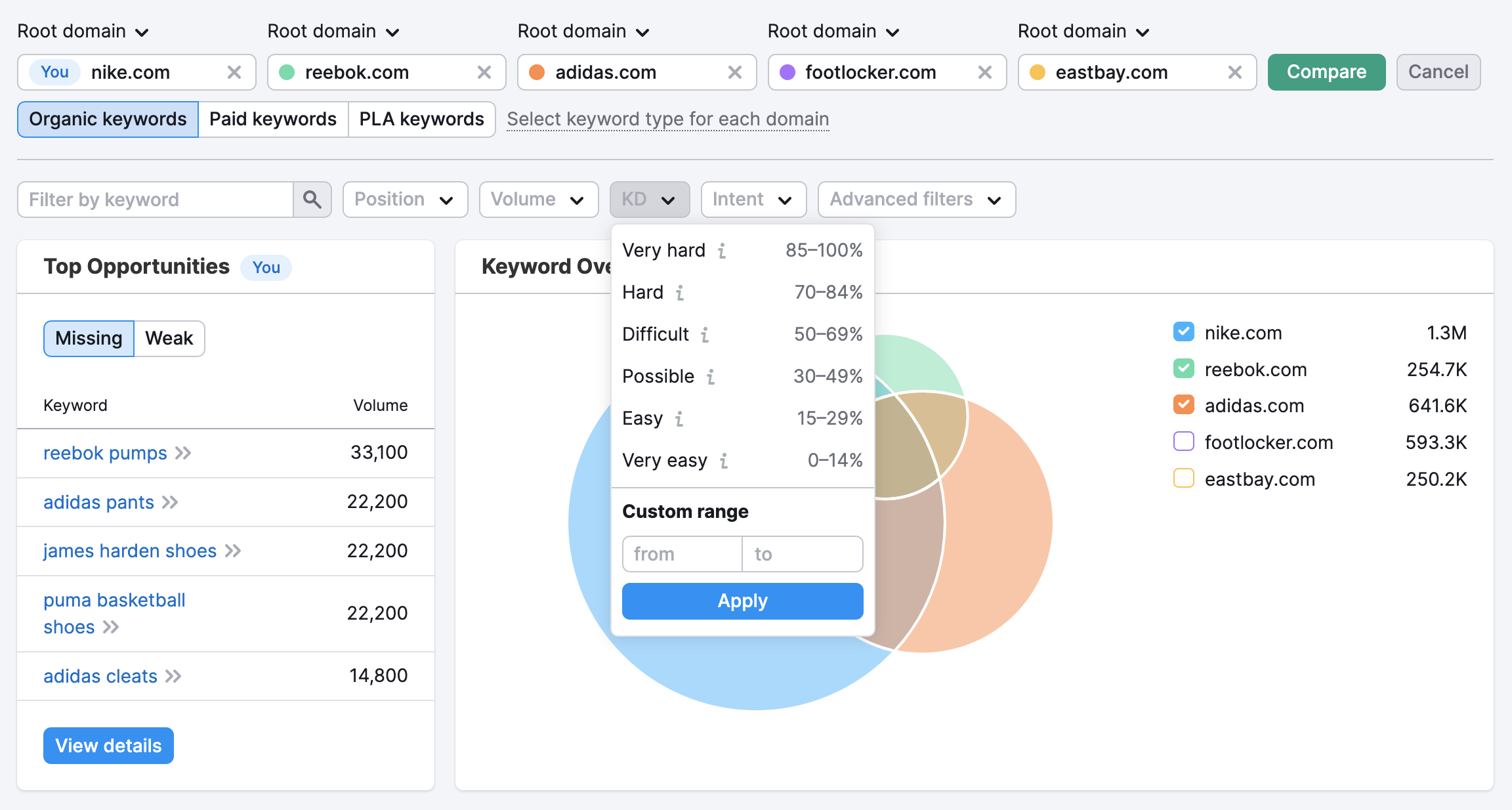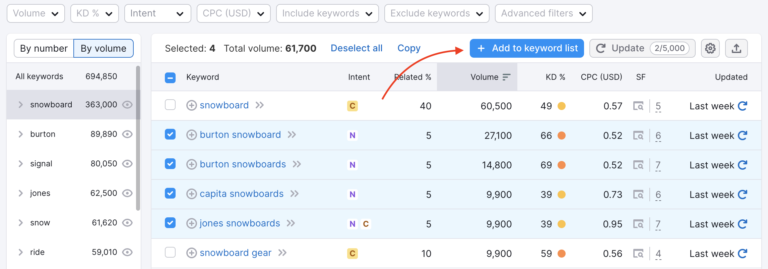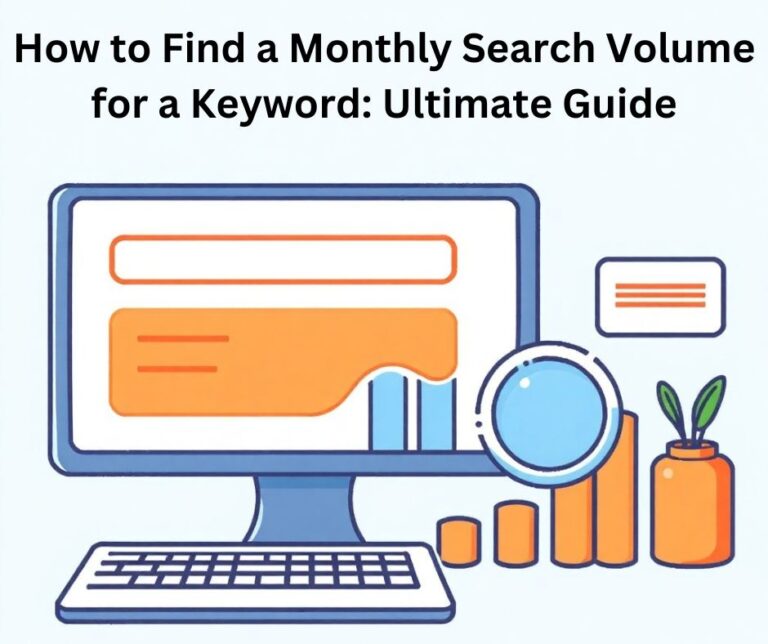Finding the right keywords is crucial for online success. Keyword Gap analysis helps you see what keywords your competitors rank for that you do not.
This can give you a significant advantage in your SEO strategy. In this blog post, we will explore how to use the Keyword Gap tool in Semrush effectively. Understanding your competition can help you identify new opportunities for your website.
By analyzing the keywords that others use, you can fill the gaps in your own content. This process can lead to better rankings and more traffic. We will break down the steps clearly so you can apply them easily. Let’s dive into the world of keyword analysis and see how it can work for you.
Introduction To Keyword Gap Analysis
Keyword Gap Analysis helps you find keywords your competitors rank for but you do not. This process reveals valuable opportunities. By using this analysis, you can improve your website’s visibility. You can attract more visitors and grow your audience.
Importance Of Competitive Keyword Analysis
Understanding your competitors’ keywords is vital for your SEO strategy. Here are some key points:
- Identify missing keywords in your content.
- Discover high-traffic keywords your competitors use.
- Analyze keyword difficulty to find achievable goals.
- Enhance your content to match industry standards.
Competitive keyword analysis helps you stay relevant. It ensures your content meets user needs. This way, you can rank higher in search results.
Role Of Semrush In Seo
Semrush is a powerful tool for keyword analysis. It offers various features to improve your SEO efforts.
| Feature | Description |
|---|---|
| Keyword Gap Tool | Find keywords your competitors rank for that you do not. |
| Domain Overview | Get insights into competitor’s overall performance. |
| Traffic Analytics | Analyze the traffic sources of competitors. |
Using Semrush helps you understand your market better. You can track your competitors’ performance easily. This data guides your content strategy effectively.

Credit: supademo.com
Getting Started With Semrush Keyword Gap Tool
The Semrush Keyword Gap Tool helps you find keywords your competitors use. It shows what you might be missing. This tool gives clear insights into your niche. With it, you can improve your SEO strategy.
Let’s explore how to use this tool effectively. Start by creating your Semrush account. Then, navigate to the Keyword Gap Tool. Follow these simple steps.
Creating A Semrush Account
To begin, visit the Semrush website. Click on the “Sign Up” button. Fill in your details to create an account. You can choose a free trial or a paid plan.
A free trial lets you explore features. Use it to understand the tool better. After registration, check your email for confirmation. Click the link to verify your account.
Navigating To The Keyword Gap Tool
Once your account is active, log in. Look for the dashboard. Find the “Keyword Gap” tool in the SEO section.
Click on it to open the tool. Enter your domain and your competitors’ domains. Then, hit the “Compare” button to see the results.
The tool will display a list of keywords. You can see which keywords you share and which you don’t. Use this information to shape your content strategy.
Setting Up Your First Keyword Gap Analysis
Keyword Gap analysis helps find gaps in your SEO strategy. It shows keywords your competitors rank for, but you do not. Using Semrush for this can boost your website traffic. Let’s dive into how to set it up.
Choosing Competitors For Comparison
Start by selecting competitors for your analysis. Focus on those who are similar to you. Look for companies in your niche that rank well.
Follow these steps:
- Identify your top competitors.
- Use Semrush to find their domain names.
- Input these domains into the Keyword Gap tool.
Choose at least three competitors. This gives you a broader view of the market. It also helps you identify more keyword opportunities.
Understanding The Keyword Gap Interface
The Keyword Gap tool in Semrush is user-friendly. It shows clear comparisons between your site and your competitors.
Here is what you will see:
| Feature | Description |
|---|---|
| Keyword List | Shows keywords both you and your competitors rank for. |
| Missing Keywords | Displays keywords your competitors rank for, but you do not. |
| Common Keywords | Highlights keywords shared between you and competitors. |
Use this information to find new keywords. Focus on the missing keywords to improve your content strategy.
Analyze the data regularly. Adjust your strategy based on the findings. This helps you stay competitive in your niche.
Interpreting Keyword Gap Results
Understanding Keyword Gap results is vital for your SEO strategy. This tool helps you see where you stand against competitors. It shows which keywords they rank for that you do not. Use this data to improve your content and attract more traffic.
Two key areas to focus on are keyword overlap and unique opportunities. These aspects will guide you in refining your strategy.
Analyzing Keyword Overlap
Keyword overlap shows what you and your competitors share. This section highlights the keywords both you and your competitors rank for. A high overlap means you are targeting similar terms.
Look at these shared keywords. Are they driving traffic to your site? Are they valuable for your audience? If they are, consider optimizing your content around these keywords. This can help improve your rankings.
Identifying Unique Opportunities
Unique opportunities reveal keywords your competitors use but you do not. These keywords can be a goldmine for your content strategy. They present a chance to reach new audiences.
Focus on these keywords. Research their search volume and competition level. Choose the ones that fit your niche and goals. Create content that targets these unique keywords. This will help you stand out in search results.
Advanced Filtering Options
The Advanced Filtering Options in Semrush help you refine your keyword research. These tools allow you to focus on specific keywords. You can filter keywords based on type and geographic location. This makes your analysis more precise and useful.
Filtering By Keyword Type
Semrush offers various keyword types. These include:
- Broad Match: Includes variations of your keywords.
- Exact Match: Matches the keywords exactly.
- Phrase Match: Contains the exact phrase.
- Related Keywords: Similar keywords that might interest you.
To filter by keyword type:
- Open the Keyword Gap tool.
- Enter your domains.
- Choose the keyword type from the filter menu.
- Click “Apply” to see results.
This filtering helps you target the right keywords. Focus on what suits your needs.
Customizing By Geographic Location
Geographic location impacts keyword performance. Semrush allows you to filter keywords by location. This is useful for businesses with local markets. You can target specific countries or regions.
To customize by location:
- Go to the Keyword Gap tool.
- Enter your domains.
- Select the desired geographic location.
- Click “Apply” to view the filtered list.
This feature helps you understand local search trends. It improves your chances of ranking higher.
Leveraging Keyword Gap For Content Strategy
Using Keyword Gap in Semrush helps refine your content strategy. It shows keywords your competitors rank for but you do not. This insight can guide your content creation. You can target valuable keywords that improve your visibility.
Finding the right keywords can boost your traffic. It can also help you connect with your audience better. Let’s explore how to spot these keywords and create content that attracts visitors.
Spotting High-potential Keywords
Start by entering your domain and a competitor’s domain in Semrush. The tool will show you the keywords your competitor ranks for. Focus on the keywords with high search volume and low competition.
Look for keywords that are relevant to your niche. These keywords should match your audience’s intent. Check the trends and search patterns for these keywords too. This helps you see which ones are gaining popularity.
Make a list of keywords that stand out. Prioritize keywords that can fill gaps in your content. This approach helps you find opportunities that others miss. You can then plan your content around these keywords.
Crafting Content Around Gap Keywords
Once you have your list, start creating content. Use the high-potential keywords in your titles and headings. This makes your content more relevant. It also helps search engines understand your focus.
Write engaging and informative articles based on these keywords. Include questions your audience might have. This keeps readers interested and encourages them to explore more.
Don’t forget to optimize your content. Use keywords naturally throughout the text. Include them in meta descriptions and image alt texts. This boosts your chances of ranking higher in search results.
Regularly check your performance. Use Semrush to track how your content ranks for these keywords. Adjust your strategy based on what works best. This helps you stay ahead of the competition.
Integrating Keyword Gap Insights With Other Semrush Tools
Using the Keyword Gap tool gives valuable insights. These insights help find keywords your competitors rank for. To get the most from this tool, combine it with other Semrush features. This approach enhances your SEO strategy. It helps you discover new opportunities.
Using Keyword Magic Tool
The Keyword Magic Tool is essential for keyword research. Start by entering keywords from your Keyword Gap report. This tool shows related keywords and their search volume. It helps you find long-tail keywords to target. Use filters to narrow your results. Focus on keywords that your competitors may overlook. This can give you an edge.
Enhancing With Position Tracking
Position Tracking allows you to monitor your keywords. Use it to track the performance of the new keywords you find. Set up your project in Semrush. Add the keywords from your Keyword Gap analysis. Check how your rankings change over time. This tool shows you where you stand against competitors. Adjust your strategy based on the data you see.

Credit: www.semrush.com
Measuring Success And Adjusting Strategy
Measuring success is key in SEO. It shows what works and what does not. Using Keyword Gap in Semrush helps track your progress. Adjusting your strategy can lead to better results. Let’s explore how to track performance and refine your approach.
Tracking Performance Over Time
Start by checking your rankings regularly. Look for changes in keyword positions. Note which keywords bring traffic. This data helps you see trends. Compare your performance with competitors. Identify gaps in your strategy.
Use Semrush to track changes. The tool shows how your rankings shift over time. Set specific time frames for tracking. Weekly or monthly checks work well. Analyze the data to find patterns.
Refining Your Seo Approach
Refine your SEO strategy based on your findings. Focus on keywords that drive traffic. Optimize your content for these terms. Adjust your content strategy to fit what users want.
Look for new keyword opportunities. Explore areas where competitors rank higher. Create content that fills these gaps. Regular updates keep your site relevant. Stay informed about trends in your niche.
Test different strategies. Try new keywords or content formats. Monitor results closely. Adjust as needed to improve performance.
Best Practices For Keyword Gap Analysis
Keyword gap analysis helps identify missed opportunities. It shows keywords that your competitors rank for, but you do not. Using this tool wisely can boost your content strategy.
Follow these best practices to get the most out of your analysis.
Regularly Updating Competitor Analysis
Competitor landscapes change often. Regular updates are key. Check your competitors’ keyword performance every few months. This keeps your data fresh.
Set reminders to revisit your analysis. Look for new competitors and emerging trends. This approach ensures you stay relevant in your niche.
Balancing Short And Long-tail Keywords
Focus on a mix of short and long-tail keywords. Short keywords have high search volume. They attract more traffic.
Long-tail keywords are specific. They often have less competition. Users searching these terms are closer to making a decision.
Using both types can maximize your reach. Aim for a balanced keyword strategy. This will attract diverse audiences to your content.

Credit: www.semrush.com
Conclusion: Staying Ahead With Keyword Gap Analysis
Keyword gap analysis is essential for any SEO strategy. It helps you find the keywords your competitors rank for but you do not. This insight can guide your content creation and optimization efforts. Let’s recap the key points and discuss how to future-proof your SEO.
Recap Of Key Takeaways
Keyword gap analysis reveals missed opportunities. Use Semrush to compare your site with competitors. Identify keywords that drive traffic to them but not you. Focus on these keywords in your content strategy. Regularly analyze your gaps. This keeps your strategy fresh and relevant.
Future-proofing Your Seo
SEO is always changing. Stay informed about trends and updates. Use keyword gap analysis regularly. This helps you adapt to new search behaviors. Track your performance over time. Adjust your strategy based on what works best.
Keep an eye on your competitors. They can provide valuable insights. By understanding their strengths, you can improve your own strategy. This proactive approach will ensure you remain competitive in your niche.
Frequently Asked Questions
How Do I Find Keyword Gaps In Semrush?
To find keyword gaps in Semrush, navigate to the “Keyword Gap” tool. Enter your domain and competitors’ domains. Semrush will generate a list of keywords that your competitors rank for but you don’t. Analyze this data to identify opportunities for content creation and SEO improvements.
What Is The Benefit Of Using Keyword Gap Analysis?
Keyword gap analysis helps identify missed opportunities. By uncovering keywords your competitors rank for, you can optimize your strategy. This analysis allows you to focus on high-potential keywords, improving your visibility and traffic. Ultimately, it supports better content targeting and enhances your overall SEO efforts.
Can I Use Keyword Gap For Ppc Campaigns?
Yes, keyword gap analysis is beneficial for PPC campaigns. It helps identify keywords that competitors use in their paid ads. By analyzing this data, you can discover new keywords to target and optimize your ad spend. This approach enhances your chances of better ROI on advertising efforts.
How Often Should I Perform Keyword Gap Analysis?
Perform keyword gap analysis regularly, ideally quarterly. Regular analysis helps you stay updated on market trends and competitor strategies. It allows you to adapt your SEO and content plans effectively. Frequent assessments ensure you’re not missing out on valuable keyword opportunities as the landscape changes.
Conclusion
Using the Keyword Gap tool in Semrush can boost your SEO efforts. It helps you find keywords your competitors rank for but you do not. This insight guides your content strategy and keyword choices. Focus on these gaps to improve your website’s visibility.
Regularly check your progress and adjust your tactics as needed. By understanding your competition, you can attract more visitors. Start using this tool today to see real results. Your website deserves the attention it can get. Take action now and watch your growth unfold.





